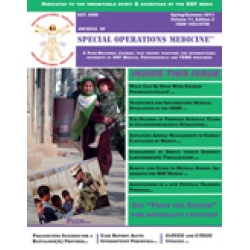Advanced Airwaymanagement In Combat Casualties By Medics At The Point Of Injury: A Sub-Group Analysis Of The Reach Study
Mabry RL, Cuniowski P, Frankfurt A, Adams BD 11(2). 16 - 19 (Journal Article)
background: Optimal airway management protocols for the prehospital battlefield setting have not been defined. Airway management strategies in this environment must take into account the injury patterns, the environment and training requirements of military prehospital providers. Methods: This is a post-hoc, sub-group analysis of the Registry of Emergency Airways Arriving at Combat Hospitals or REACH database. This study examines only those patients who had advanced airways placed for trauma by an enlisted military medic at the point of injury. results: Twenty (100%) of the patients had a traumatic injury, 19 (95%) were male, and 13 (65%) had a gun shot wounds (GSWs) as the mechanism of injury. The majority, 12 (60%) patients had an esophageal-tracheal airway device placed. Of the remaining patients, four (20%) underwent endotracheal intubation, three (15%) had a surgical cricothyroidotomy performed, and one (5%) had a Laryngeal Mask Airway (LMA) placed. Seventeen (85%) of the twenty patients were dead on arrival or died shortly after arrival at the Combat Support Hospital (CSH). All of the patients that died had a Glasgow Coma Scale (GCS) of three upon arrival. The Glasgow Coma Scale provides a score in the range 3-15; patients with scores of 3-8 are usually said to be in a coma. Three patients in this group survived to transfer from the CSH. Two of the transfers were lost to follow up, one with a GSW to the head and GCS of three, the other with a GCS of five from injuries sustained in an explosion. The third patient had a surgical cricothyroidotomy (SC) performed in the field for an expanding neck hematoma and recovered fully following surgery. conclusions: Casualties that tolerate invasive airway management without sedation in the context of trauma prognosticates a very high mortality. Airway management algorithms for military providers should reflect the casualties encountered on the battlefield not patients in cardiac arrest which predominate in the civilian EMS airway management practice. Further data are needed to understand the injuries encountered on the battlefield and to develop airway management solutions that optimize outcomes of patients with battlefield trauma.


 Español
Español 




